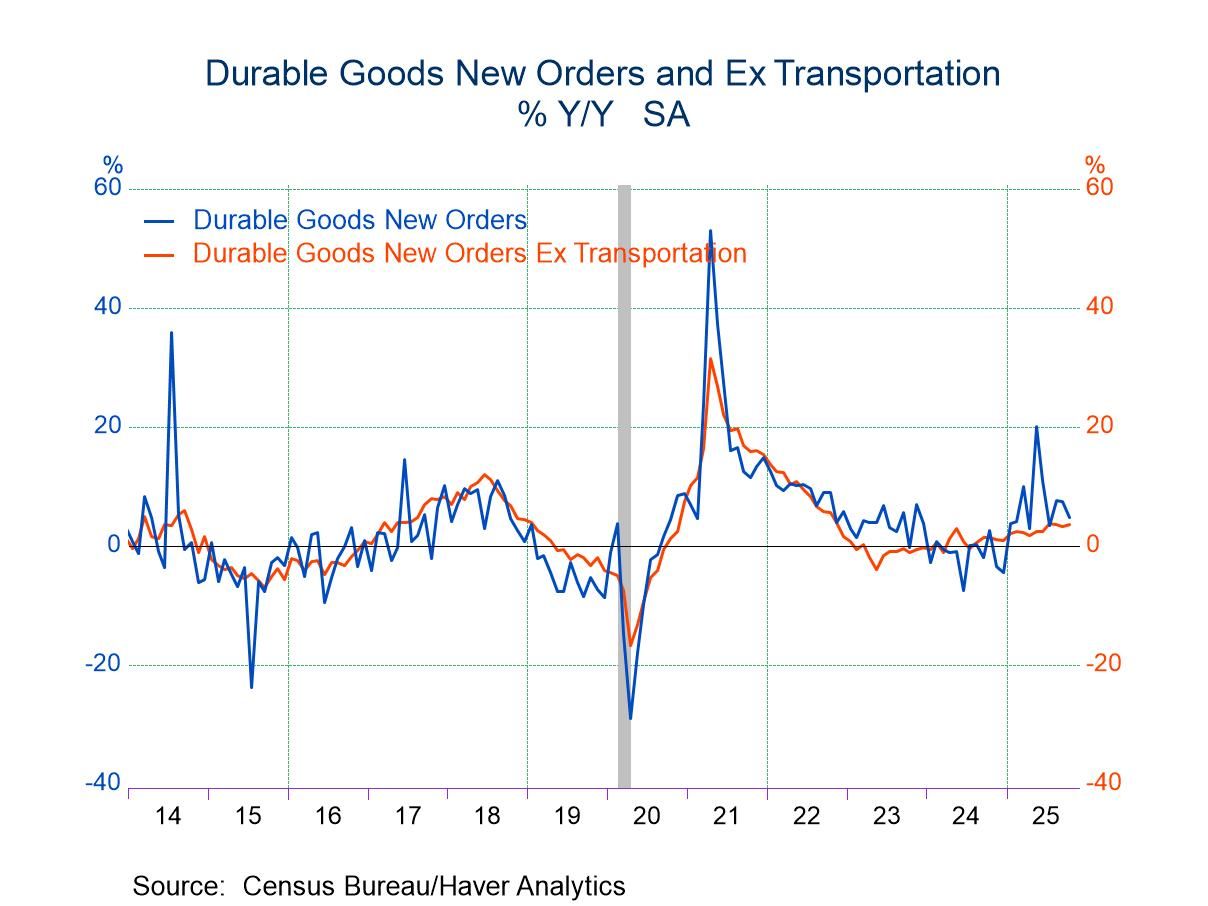U.S. Personal Spending Is Unexpectedly Strong in April; Inflation Moderates
by:Tom Moeller
|in:Economy in Brief
Summary
- Spending gain led by broad-based durable goods strength.
- Core price inflation moderates.
- Wage & salary growth remains firm.


Income & spending growth remains solid in the consumer sector of the economy. Personal consumption expenditures increased 0.9% (9.2% y/y) during April following a 1.4% March gain, revised from 1.1%. A 0.6% rise had been expected in the Action Economics Forecast Survey. Adjusted for price inflation, spending increased 0.7% last month (2.8% y/y) after rising 0.5% in March.
Real spending on durable goods surged 2.3% in April (-6.5% y/y) following a 0.7% increase. Labor market strength prompted a 3.9% surge (-18.3% y/y) in real outlays on motor vehicles & parts after a revised 2.5% March increase, initially reported as a 2.0% drop. Real outlays on recreational goods & vehicles improved 2.1% (3.7% y/y) after easing 0.1% in March. Real spending on home furnishings & appliances improved 0.5% (-7.8% y/y) after declining in the prior two months. Real nondurable goods buying rose 0.2% in April (-0.5% y/y) after a 0.1% easing. Adjusted for inflation, clothing outlays surged 1.9% (0.3% y/y) after a 0.6% March rise. Real food & beverage expenditures fell 1.0% (-3.7% y/y), down in five of the last six months. Real spending on gasoline & other energy products eased 0.1% (+1.2% y/y) after falling 1.9% in March.
Real outlays on services improved 0.5% (5.9% y/y) last month following three months of similar increase. Real outlays on recreation services surged 1.5% (17.3% y/y) after gains of 1.9% and 2.0% in the prior two months. Real spending at hotels & restaurants jumped 1.3% last month (10.9% y/y), the third straight month of strong increase. Financial services outlays rose 0.4% in April (5.1% y/y) after increasing 0.7% while housing & utilities spending improved 0.2% (1.7% y/y) after holding steady during the prior month.
Pricing power eased last month. The PCE chain price index rose 0.2% in April (6.3% y/y) following a 0.9% March increase. The price index excluding food and energy rose 0.3% (4.9% y/y) for the third straight month. These monthly increases are below the gains in each of the prior four months. Durable goods prices edged 0.1% higher (8.4% y/y) after two straight 0.2% declines prompted by lower motor vehicle prices. The nondurables goods price index eased 0.3% last month (+10.1% y/y) after rising 2.8% in March. Gasoline & oil costs fell 5.2% (+42.9% y/y) after surging 18.0% in March. Despite the decline, energy product prices remain near record levels. The services price index rose 0.5% (4.6% y/y) for the second straight month. Hotel & restaurant prices rose 0.7% (7.5% y/y) for the second straight month while housing & utilities prices rose 0.6% (5.5% y/y), also for the second consecutive month.
Personal income rose 0.4% (2.6% y/y) during April following a 0.5% rise. A 0.6% increase had been expected. Wages & salaries increased 0.6% last month (11.7% y/y) after a 0.7% increase in March. Rental income jumped 1.3% (5.4% y/y) following three months of minimal increase while proprietors' income fell 0.5% (+3.1% y/y) after a 0.9% rise. Transfer receipts eased slightly (-17.4% y/y) after rising 0.2% in March.
Disposable personal income increased 0.3% (-0.3% y/y) in April after rising 0.4% in March. Adjusted for price inflation, disposable income held steady (-6.2% y/y) after a 0.5% decline.
The personal savings rate fell to 4.4% in April from 5.0% in March. It was the lowest level since September 2008, down from a high of 33.8% in April of 2020. The level of personal savings fell 11.6% last month and has fallen by roughly two-thirds during the last twelve months.
The personal income and consumption figures are available in Haver's USECON database with detail in the USNA database. The Action Economics figures are in the AS1REPNA database.


Tom Moeller
AuthorMore in Author Profile »Prior to joining Haver Analytics in 2000, Mr. Moeller worked as the Economist at Chancellor Capital Management from 1985 to 1999. There, he developed comprehensive economic forecasts and interpreted economic data for equity and fixed income portfolio managers. Also at Chancellor, Mr. Moeller worked as an equity analyst and was responsible for researching and rating companies in the economically sensitive automobile and housing industries for investment in Chancellor’s equity portfolio. Prior to joining Chancellor, Mr. Moeller was an Economist at Citibank from 1979 to 1984. He also analyzed pricing behavior in the metals industry for the Council on Wage and Price Stability in Washington, D.C. In 1999, Mr. Moeller received the award for most accurate forecast from the Forecasters' Club of New York. From 1990 to 1992 he was President of the New York Association for Business Economists. Mr. Moeller earned an M.B.A. in Finance from Fordham University, where he graduated in 1987. He holds a Bachelor of Arts in Economics from George Washington University.






